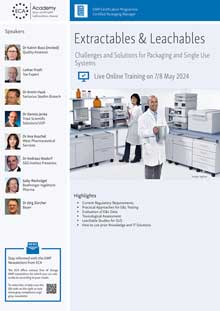New EU Regulation lowers BPA Limit

Recommendation
7/8 May 2024
Challenges and Solutions for Packaging and Single Use Systems
Last year, the draft Regulation on the use of bisphenol A in varnishes and coatings intended to come into contact with food and amending Regulation (EU) No 10/2011 as regards the use of that substance in plastic food contact materials was published. Now, the European Commission (EC) published its final Commission Regulation (EU) 2018/213 in the Official Journal on February 14, 2018. The regulation further restricts the use of Bisphenol A (BPA) in certain food-contact materials, introduces a specific migration limit (SML) for BPA in varnishes and coatings and revises the SML for BPA in the "Plastics Regulation" 10/2011.
While the regulation applies to foodstuff packaging, it indirectly also affects packaging materials used for oral and topical medicinal products - since for these packaging materials compliance with foodstuff regulation is required (e.g. by the European guideline on plastic immediate packaging materials). BPA is, for example, commonly used as a starting substance for inner coatings (epoxy resins) of aluminum tubes and cans for aerosols. So far, the "Plastics Regulation" 10/2011 did not apply to varnishes and coatings. Specifically, Regulation 2018/213 establishes a SML of 0.05 mg BPA per kg of food (or food simulants) for varnishes and coatings. No migration of BPA (detection limit = 0.01 mg/kg) is allowed for those varnishes and coatings which are intended to be applied on materials and articles specifically intended to come into contact with infant formula, follow-on formula, processed cereal-based food, baby food, or food for special medical requirements of infants and young children. With respect to the "Plastics Regulation" 10/2011, the new BPA Regulation reduces the SML for BPA from 0.6 mg/kg to 0.05 mg/kg and expands the ban on the use of BPA in the manufacture of polycarbonate infant feeding bottles to polycarbonate drinking cups or bottles which, due to their spill proof characteristics, are intended for infants and young children.
The Regulation also specifies that business operators shall ensure that varnished or coated materials/ articles are accompanied by a written declaration of compliance (DoC) that is available at all stages of manufacture, processing, and distribution other than the retail stage. The DoC contains the following specific information laid down in Annex I of the Regulation:
- identity and address of the business operator issuing the DoC;
- identity and address of the business operator which manufactures or imports the coated material/ article;
- identity of the varnished or coated material/ article;
- the date of the declaration;
- confirmation that the varnish or coating applied to the material/ article meets the restrictions laid down in this Regulation and the requirements of EU Regulation 1935/2004;
- specifications on the use of the coated material/ article (i.e. type(s) of food with which it is intended to be put into contact, time and temperature of treatment and storage in contact with food, highest food contact surface area to volume ratio for which compliance has been verified).
Furthermore, the DoC "shall permit an easy identification of the varnished or coated materials and articles to which it applies. It shall be renewed to reflect any changes in migration levels from the varnish or coating that has been applied to materials and articles." Business operators shall, upon request of a national competent authority, make available appropriate supporting documentation. Such supporting documentation shall be provided without delay (not later than 10 days following receipt of the request). The supporting documentation shall contain the conditions and results of the testing and calculations, including modelling, other analysis, and evidence on the safety or reasoning demonstrating compliance.
The BPA Regulation enters into force 20 days after its publication in the Official Journal and will apply from September 6, 2018. Varnished or coated materials/ articles and plastic materials/ articles that were lawfully placed on the market before that date may remain on the market until exhaustion of stocks. With its new Regulation the EC follows the EFSA opinion published in January 2015.
However, the FDA recently informed that the National Toxicology Program (NTP) released for public comment a pre-peer review draft report on the findings of a comprehensive study examining the potential effects of BPA on health. the FDA says "the initial review supports FDA´s determination that currently authorized uses of BPA continue to be safe for consumers". The report also builds upon the already extensive data collected in FDA’s 2014 assessment of the safety of BPA. While in the U.S. BPA can’t be used in baby bottles and sippy cups (similar to EU regulations) this does not apply more broadly to the use of BPA in other containers and the FDA study currently finds no reason to limit Bisphenol A.
Related GMP News
GMP Conferences by Topics
- General Quality Assurance and GMP Compliance Topics
- Hygiene
- General Microbiology Topics
- Regulatory Affairs
- Development
- General Analytics Topics
- Good Distribution Practice
- Sterile Manufacturing
- Computer Validation
- General Qualification/Validation Topics
- General Engineering Topics
- APIs/Excipients
- GMP Basic Training Courses
- Medical Devices and Combination Products
- Packaging and Packaging Material
- Data Integrity
- Qualified Person (QP)
- GMP Auditing
- Documentation
- Cleaning Validation
- General IT Compliance Topics
- Impurities
- OOS / OOE / OOT
- Material Testing
- Validation of Analytical Methods
- Analytical Instrument Qualification
- Stability Testing
- Microbiological Testing
- Technology
- General Manufacturing Topics
- Solid Dosage Forms/Semi-Solid Dosage Forms
- Biotechnology/Blood/ATMP
- Herbal Drug Products/Cannabis/Radiopharmaceuticals
- Others




